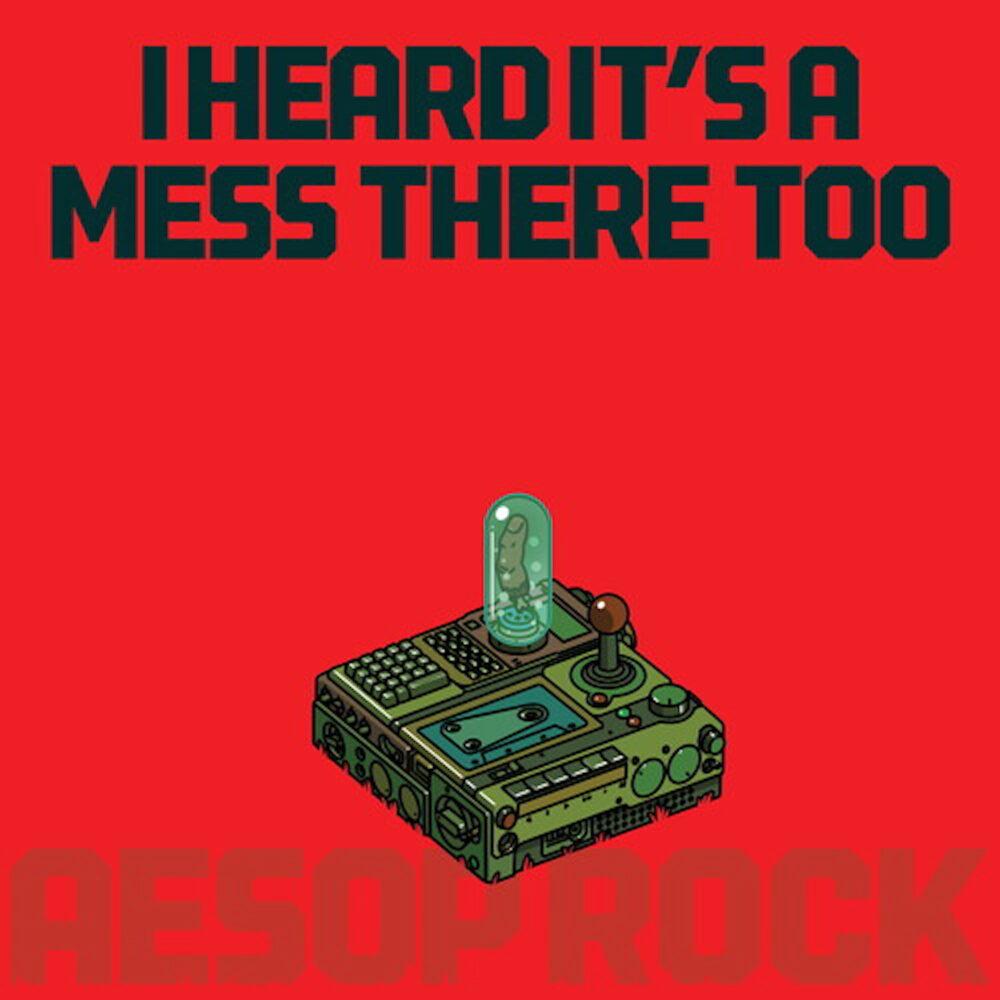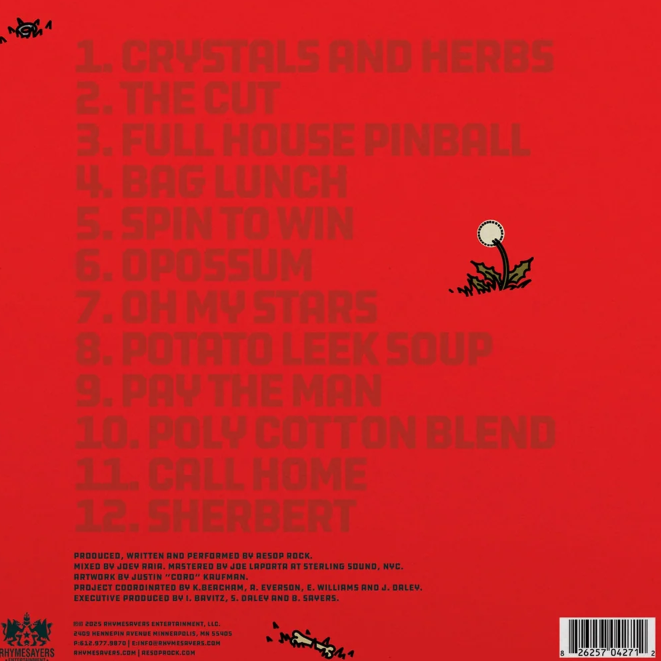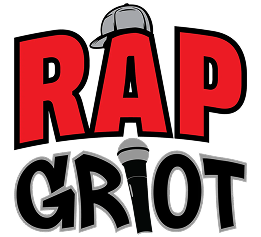
Aesop Rock has been making complex, self-contained worlds out of words and beats for more than two decades. I Heard It’s a Mess There Too, his second album of 2025 and twelfth overall, arrives without warning—streamed for free on YouTube, available for download, and only later pressed to vinyl and cassette. It’s a very Aesop move: generous, independent, and uninterested in the traditional industry cycle. The record finds him producing everything himself again, continuing the streak of self-sufficient creativity that’s defined his career since The Impossible Kid. But where June’s Black Hole Superette was dense and layered, I Heard It’s a Mess There Too is stripped back and open, its clarity revealing new sides of his craft.
Aesop (real name Ian Bavitz) has long been known as Hip Hop’s most meticulous wordsmith, but his production chops have caught up to his writing. The beats here are cleaner, less cluttered. He described them as “enough to get a wave rolling,” and that’s exactly what they do: sparse drums, calm basslines, and textures that hum instead of crowd. It’s minimal in the literal sense, but not bare—each sound is placed with care. The album plays like a late-night drive through the outskirts of somewhere familiar, headlights cutting through fog. The mood is conversational, self-aware, a little exhausted, but never cynical.
“Crystals and Herbs” opens the record with a crooked groove that clicks into rhythm as Aesop starts listing the ways a person can stay afloat in a broken system. The drums snap dryly against dusty loops while his voice threads through the noise, precise but weary. “The Cut” follows with an eerie synth line that curls around the kick drum. The track’s small, echoing space makes his verses sound closer, like he’s talking from across a dim room.
“Full House Pinball” shifts the energy, bouncing along with springy percussion and quick-hit piano samples. It’s one of the few bright spots on the album, not because it’s happy, but because the rhythm moves with real ease. He raps about fresh air and long walks as therapy, a reminder that his sense of humor still slips through the clutter. Then “Bag Lunch” pulls things back to street level, with Aesop describing locked-down neighborhoods and routines that keep people sane when everything else feels unstable. The beat here is heavy and grounded, moving slow enough to let the images settle.
Mid-album, the production becomes more elastic. “Spin to Win” leans on a funky bass loop and loose percussion that swing like a half-remembered 1970s jam. He raps about the chaos of staying active—whipping around the woods, bumping into life at weird angles—and it sounds like he’s smiling through the frustration. “Opossum” rides a low, thudding rhythm that recalls 1990s New York but through Aesop’s crooked lens. The lyrics are surreal and detailed, a collage of nocturnal scenes and shifting identities.
By “Oh My Stars,” the tone has softened. The track drifts, a flutter of muted synths and drums that land like soft taps on glass. Aesop talks about feeding crows donuts and wandering without a clear plan. It’s funny, small, and moving in the way only he can make it—ordinary moments refracted through restless thought. “Potato Leek Soup” follows with a bit of grit, the beat crackling like an old field recording. He raps about kids running through streets, about fear and play occupying the same territory.
The final third of the album is its strongest stretch. “Pay the Man” builds on a straight boom-bap rhythm, simple and sure, while chimes float in the background. The energy is confident, even playful—Aesop tossing metaphors with the ease of someone who has nothing left to prove. “Poly Cotton Blend” keeps the tempo high, working around a tight drum break and chopped vocal snippets. It’s one of his sharpest production moments, showing how his minimalism leaves more space for motion.
“Call Home” slows the album’s pulse, pulling together the project’s themes of distance, communication, and disconnection. It’s a song about checking in—on friends, on the world, on himself—and realizing that everything everywhere is falling apart in its own way. The line between personal reflection and social commentary blurs naturally. He doesn’t lecture; he observes. “Sherbett” closes the record on a loose, meditative note, with airy synths and muted percussion drifting behind his voice. The words are abstract, almost dreamlike, ending the record in a kind of quiet release.

Across its twelve tracks, I Heard It’s a Mess There Too is the sound of an artist trimming away everything unnecessary. The drums are dry and human, the basslines warm but restrained. Small textures—a single synth swell, a faint hum of static—carry emotional weight. Aesop’s voice is in front of it all, steady and expressive. His writing remains dense, but there’s a looseness in how he moves through it now. He pauses, laughs, doubles back on phrases. He’s conversational without losing precision.
Lyrically, the album wrestles with global anxiety in small, local terms. The title came from checking in with friends abroad and realizing every place has its own disaster. There’s no grand solution here—only acknowledgment, humor, and small rituals for survival. Aesop’s version of optimism is pragmatic: water the plants, walk the dog, touch grass, stay connected where you can. It’s a record about maintaining sanity through small acts of attention.
The production shift is key to its effect. The minimal beats aren’t a retreat from complexity but a recalibration. They leave air between sounds, and that space lets the writing breathe. The result is music that feels lived-in, calm, and direct, even when the words twist into surreal tangles. He doesn’t sound nostalgic or bitter, just grounded—an artist in his forties still fully engaged with the craft, but moving at his own rhythm.
I Heard It’s a Mess There Too is an album of precision and restraint. It’s not grand or cinematic, but it doesn’t need to be. Its power comes from how carefully it’s built, how clean the balance is between rhythm and reflection. Aesop Rock continues to find new ways to sound like himself without repeating old patterns. At a time when many artists chase trends or polish their edges for algorithmic approval, he continues to carve his own path—sharp, funny, deeply human, and always tuned to the quiet music of everyday confusion.
8.5/10
Also read: The Best Hip Hop Albums Of 2025
